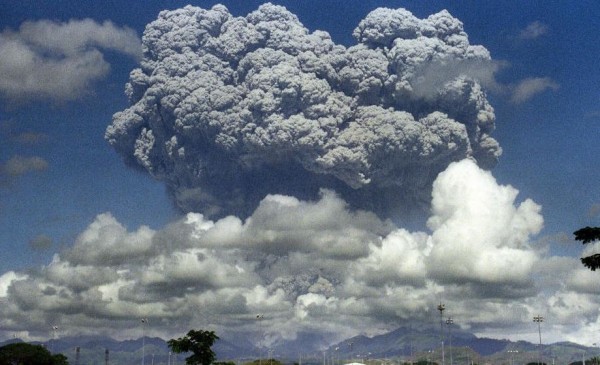To Cool the Earth, 'Do a Pinatubo' Geoengineering
| Arthur Dominic Villasanta | | Feb 25, 2015 10:22 PM EST |
Mount Pinatubo eruption, July 1991, the second most powerful in the 20th century.
It might sound outlandish but one "solution" being bruited about to counteract global warming is to "Do a Pinatubo".
That doesn't mean triggering a catastrophic volcanic eruption. What is does mean is pumping enough material into the atmosphere to reflect sunlight back into space, cooling down the climate. This is geoengineering or climate engineering at work.
Like Us on Facebook
Some climate scientists believe cooling the climate can be brought about by scattering sulfur particles in the upper atmosphere that re-direct sunlight back into outer space. This cooling was precisely what occurred when Mount Pinatubo in the Philippines erupted in July 1991.
This stupendous eruption, the second greatest in the 20th century, hurled 20 million tonnes of sulfur dioxide high into the sky above the Philippines. The droplets of sulfuric acid that formed on contact with moisture reflected incoming sunlight back into space, preventing that radiation from warming the planet's surface.
Over the next few months, the aerosols formed a global layer of sulfuric acid haze. Global temperatures dropped by about 0.5 °C (0.9 °F) from 1991 to 1993, and ozone depletion temporarily increased substantially.
Some climate scientists are suggesting humanity could duplicate the Pinatubo Effect by deliberately seeding the stratosphere with sulfur. The only problem is this quick fix solution looks good only on paper and hasn't been validated by scientific study.
Climate scientist Prof. Alan Robock from Rutgers University noted we have no real knowledge of how such a strategy would work.
"We'd like to be able to see how this sulfur dioxide cloud evolves from gas into particles and how the particles grow," he said to BBC News.
"If the particles are too big, then they'll fall out much more rapidly and you'd have to replenish them much more rapidly, if you're interested in doing geoengineering. And so we'd like to understand the processes in the formation of these droplets," he added.
The American Association for the Advancement of Science said there is insufficient insight into the likely consequences of climate intervention techniques such as "Doing a Pinatubo" to justify their use.
Geoengineering skeptics also note that apart from cooling the climate, Mount Pinatubo disrupted the Asian monsoons and by limiting direct sunlight reduced the capability of solar power generation. Geoengineering advocates, however, believe large-scale intervention in the Earth's climatic system can be pivotal in offsetting the hostile effects of climate change.
"We need more information to know what the relative benefits and the relative risks would be, and so we need a lot more research", said Prof Robock.
©2015 Chinatopix All rights reserved. Do not reproduce without permission
EDITOR'S PICKS
-

Did the Trump administration just announce plans for a trade war with ‘hostile’ China and Russia?
-

US Senate passes Taiwan travel bill slammed by China
-

As Yan Sihong’s family grieves, here are other Chinese students who went missing abroad. Some have never been found
-

Beijing blasts Western critics who ‘smear China’ with the term sharp power
-

China Envoy Seeks to Defuse Tensions With U.S. as a Trade War Brews
-

Singapore's Deputy PM Provides Bitcoin Vote of Confidence Amid China's Blanket Bans
-

China warns investors over risks in overseas virtual currency trading
-

Chinese government most trustworthy: survey
-

Kashima Antlers On Course For Back-To-Back Titles
MOST POPULAR
LATEST NEWS
Zhou Yongkang: China's Former Security Chief Sentenced to Life in Prison

China's former Chief of the Ministry of Public Security, Zhou Yongkang, has been given a life sentence after he was found guilty of abusing his office, bribery and deliberately ... Full Article
TRENDING STORY

China Pork Prices Expected to Stabilize As The Supplies Recover

Elephone P9000 Smartphone is now on Sale on Amazon India

There's a Big Chance Cliffhangers Won't Still Be Resolved When Grey's Anatomy Season 13 Returns

Supreme Court Ruled on Samsung vs Apple Dispute for Patent Infringement

Microsoft Surface Pro 5 Rumors and Release Date: What is the Latest?










